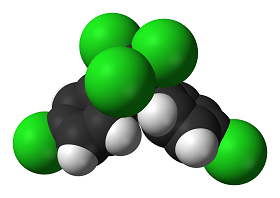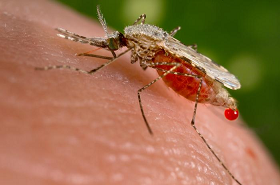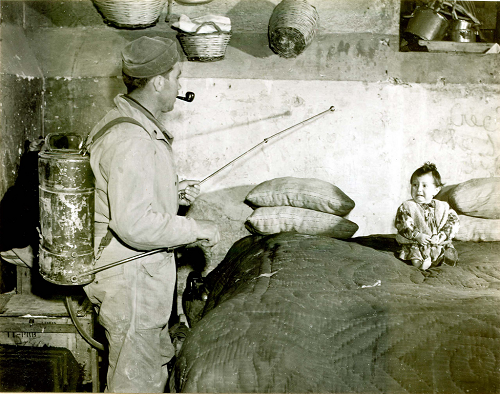Imt/2012/04/16/50 Years After Silent Spring The Rehabilitation Of Ddt And The De Habilitation Of Rachel Carson - ThomasNet News
When I was a teenager, the grownups around me were in raptures over Rachel Carson's 1962 book,
-- a poetically written exposé that raised fears about chemical pesticides, which were going to kill all the birds, and possibly us, too. I thought
was wonderful and demonstrated much that was wrong with the greedy, destructive industrialized system that the past few generations had built up in their mad fervor to conquer nature and make money. Never mind that I hadn't actually read the book. Given that history, I was surprised recently to learn that critics are blaming Carson for millions of malaria deaths, supposedly because she was responsible for using junk science to promote the banning of DDT (dichlorodiphenyltrichloroethane), a marvelous substance that has never been proven harmful to humans. In the
 Rachel Carson. Credit: U.S. Fish and Wildlife Service[/caption Rachel Carson (1907-1964) worked for much of her life as a marine biologist for the U.S. Fish and Wildlife Service. She was already known as a science writer when she published 1962's Silent Spring, in which she argued that the uncontrolled use of pesticides was harming and killing animals, birds, and humans. After reading some of the criticisms of Carson from recent years, I suspected that many of her detractors had never actually read the book they were condemning. I confess, I had never read Silent Spring myself until about six months ago, but I hate to comment on a book I've never read, so I decided it was time to find out what all the fuss was about. I can say now that Silent Spring truly is beautifully written. You can just thumb through and find at almost any point a passage such as this, in which Carson describes the effects of herbicide spraying:
Rachel Carson. Credit: U.S. Fish and Wildlife Service[/caption Rachel Carson (1907-1964) worked for much of her life as a marine biologist for the U.S. Fish and Wildlife Service. She was already known as a science writer when she published 1962's Silent Spring, in which she argued that the uncontrolled use of pesticides was harming and killing animals, birds, and humans. After reading some of the criticisms of Carson from recent years, I suspected that many of her detractors had never actually read the book they were condemning. I confess, I had never read Silent Spring myself until about six months ago, but I hate to comment on a book I've never read, so I decided it was time to find out what all the fuss was about. I can say now that Silent Spring truly is beautifully written. You can just thumb through and find at almost any point a passage such as this, in which Carson describes the effects of herbicide spraying:I know well a stretch of road where nature's own landscaping has provided a border of alder,viburnum, sweet fern, and juniper with seasonally changing accents of bright flowers, or of fruits hanging in jeweled clusters in the fall.The road had no heavy load of traffic to support; there were few sharp curves or intersections where brush could obstruct the driver's vision. But the sprayers took over and the miles along that road became something to be traversed quickly, a sight to be endured with one's mind closed to thoughts of the sterile and hideous world we are letting our technicians make. But here and there authority had somehow faltered and by an unaccountable oversight there were oases of beauty in the midst of austere and regimented control -- oases that made the desecration of the greater part of the road the more unbearable. In such places my spirit lifted to the sight of the drifts of white clover or the clouds of purple vetch with here and there the flaming cup of a wood lily.
Silent Springcontained extensive documentation of the damage of DDT and other pesticides to fish, birds, and other animals.
(Photo: DDT fogging, Australia, 1962. Credit: Ken Hodge
.)
The public received Carson's book enthusiastically. However, according to Zuoyue Wang, writing inScience Communication("Responding to Silent Spring: Scientists, Popular Science Communication, and Environmental Policy in the Kennedy Years," 1997), "The initial reception of the book by the scientific community, the chemical industry, and some agricultural officials in the Kennedy administration was not so positive..."In 1963, though, President John F. Kennedy's President's Science Advisory Committee (PSAC) released its Use of Pesticides report, which "was universally greeted as a vindication of Rachel Carson and became a harbinger to change in federal policy," Wang writes. "While recognizing the indispensable role of pesticides in modern agriculture, the PSAC report reaffirmed Carson's warnings about the harmful effects of persistent pesticide use and called for tighter government controls to protect the environment and human health."The U.S. Senate held hearings in response to the PSAC report. Wang writes:The ... hearings brought to light the division in the scientific community over the effects of pesticides and what to do about them. Although Carson and several other scientists gave strong support to the PSAC report, a number of agricultural scientists and public health officials disagreed with PSAC on the danger of pesticides and the desirability of the limitation of persistent pesticides. Emil M. Mrak, chancellor of the University of California at Davis and professor of food science, for example, said the PSAC statement that pesticides were "affecting biological systems in nature and may eventually affect human health" was "contrary to the present body of scientific knowledge."
Eventually, in 1970, the Environmental Protection Agency (EPA) under President Richard Nixon banned the use of DDT in the U.S.However, as the quotations above from Thomas Sowell and the Competitive Enterprise Institute show, the controversy did not end with the 1963 PSAC report or the 1970 DDT ban.DDT Becomes Our Friend Again
According to the World Health Organization(WHO), in 2010 malaria caused about 216 million infections and 655,000 deaths, mostly among African children. The parasite that causes malaria is transmitted only through the bite of theAnophelesmosquito, so control of that pest is a key preventive measure. About the use of pesticides and DDT in particular, the WHO says:
Indoor residual spraying (IRS) with insecticides is the most powerful way to rapidly reduce malaria transmission. Its full potential is realized when at least 80% of houses in targeted areas are sprayed. Indoor spraying is effective for 3-6 months, depending on the insecticide used and the type of surface on which it is sprayed. DDT can be effective for 9-12 months in some cases. Longer-lasting forms of IRS insecticides are under development.
In 2006, the WHO announced that, 30 years after indoor spraying of DDT was phased out, the organization was once again recommending its use in controlling malaria. In an announcementthat year, Dr. Anarfi Asamoa-Baah, the WHO's assistant director-general for HIV/AIDS, TB, and Malaria, was quoted asserting:
The scientific and programmatic evidence clearly supports this reassessment. Indoor residual spraying is useful to quickly reduce the number of infections caused by malaria-carrying mosquitoes. IRS has proven to be just as cost effective as other malaria prevention measures, and DDT presents no health risk when used properly.
The WHO announcement said that "Extensive research and testing has since demonstrated that well-managed indoor residual spraying programs using DDT pose no harm to wildlife or to humans."The President's Malaria Initiative(PMI), a component of the U.S. government's Global Health Initiative, is directed particularly at fighting malaria in Africa. The PMI web site calls indoor residential spraying
"a proven and highly effective malaria control measure" and says the WHO "has approved 12 insecticides it considers effective and safe for use in IRS, including DDT."
DDT: Safe Enough to Eat?
 In Michael Crichton's 2004 novelState of Fear, one of his characters says, "Banning DDT killed more people than Hitler ... It was so safe you could eat it."(Illustration: DDT molecule. Credit: Ben Mills
In Michael Crichton's 2004 novelState of Fear, one of his characters says, "Banning DDT killed more people than Hitler ... It was so safe you could eat it."(Illustration: DDT molecule. Credit: Ben Mills.)In its position statement on malaria and DDT, the Sierra Club
says that it "strongly disagrees with the WHO's denial of the potential health and environmental risks of using DDT" and that the organization is "deeply concerned that WHO's new position statement on 'indoor residual spraying' increases the potential for widespread misuse and accidents due to the continued manufacture, storage and applications of DDT."The Sierra Club stresses that "many effective non-toxic and less toxic alternatives are available and affordable, such as cleaning mosquito breeding areas, use of treated nets and early malaria detection and treatment programs." For that reason, the group believes DDT should be used only as an "option of last resort" and "should only be used in accordance with limiting provisions agreed to by more than 150 nations in the Stockholm Convention."The Stockholm Convention on persistent organic pollutants (POPs) is a global treaty signed by 92 countries and the European Union designed to restrict and eventually eliminate the use of a number of chemical compounds, including DDT. The Convention restricts the use of DDT only to disease vector control, such as prevention by indoor residential spraying. In discussing the effects of DDT
, the Convention's web site states:
DDT continues to be applied against mosquitoes in several countries to control malaria. Its stability, its persistence (as much as 50% can remain in the soil 10-15 years after application), and its widespread use have meant that DDT residues can be found everywhere; residual DDT has even been detected in the Arctic.Perhaps the best known toxic effect of DDT is egg-shell thinning among birds, especially birds of prey. Its impact on bird populations led to bans in many countries during the 1970s. Although its use had been banned in many countries, it has been detected in food from all over the world. Although residues in domestic animals have declined steadily over the last two decades, food-borne DDT remains the greatest source of exposure for the general population. The short-term acute effects of DDT on humans are limited, but long-term exposures have been associated with chronic health effects. DDT has been detected in breast milk, raising serious concerns about infant health.
InSilent Spring, Rachel Carson's primary concern was the indiscriminate and unquestioning use of DDT and similar pesticides in agriculture. However, she also questioned DDT's value for malaria prevention, pointing to theAnopheles'development of resistance to the pesticide even back then. The widespread use of DDT in agriculture had thus made it less effective for disease prevention.In its position statement on IRS, the WHO acknowledges that resistance is still a problem in the efficacy of insecticides:
IRS will only be effective if the target vectors are susceptible to the insecticide in use. The development of resistance to insecticides constitutes a major threat to the chemical control of malaria vectors, as it compromises the insecticide's efficacy. In the past, countries deploying IRS have often been forced to switch to alternative and more expensive insecticides on account of the development of vector resistance. Outside Africa, the prevalence and distribution of insecticide resistance in malaria vectors have not, so far, been a major impediment to insecticide-based interventions, except in some areas of India, the Middle East and Central America.However, in Africa, the potential threat of resistance to public health insecticides appears to be significant... The selection of resistance in most malaria vectors is thought to be largely the result of past and present use of insecticides in agriculture. The precise operational implications of insecticide resistance are not yet fully understood.
 The WHO calls for "a comprehensive assessment of resistance at the local level ... before planning any IRS programme, especially in West and Central Africa" and for "the careful monitoring of the susceptibility of malaria vectors to insecticides throughout the world, and the sound management of resistance."(Photo: Anopheles mosquito. Credit: Centers for Disease Control and Prevention, U.S. Department of Health and Human Services.)So, is DDT safe for humans?When Rachel Carson wroteSilent Spring, DDT was suspected as a human carcinogen, but that hadn't been proven as yet. The chemical was suspected of causing other human harm as well. Carson wasn't primarily concerned with direct human health effects; her thesis was that DDT and similar pesticides were damaging to ecosystems and that the deterioration of ecosystems would be damaging to humans.Since then, however, a little more research has been done on DDT's effects on humans.For example, Dr. Barbara A. Cohn and colleagues published a study of blood samples taken from pregnant women in Oakland, Calif., from 1959 to 1967. Researchers more recently went back and tested the blood samples for DDT and its breakdown product DDE (Dichlorodiphenyldichloroethylene). Comparing the results with subsequent rates of breast cancer among those women, now in their 50s and 60s, the researchers found that "high levels of serum p,p'-DDT predicted a statistically significant 5-fold increased risk of breast cancer among women who were born after 1931." (See "DDT and Breast Cancer in Young Women: New Data on the Significance of Age at Exposure," Barbara A. Cohn et al,Environmental Health Perspectives, October 2007.)In 2008, a group of DDT experts met for an international conference on DDT and conducted a review of the scientific literature on the health risks of the pesticide. They published their results in a report, titled "The Pine River Statement: Human Health Consequences of DDT Use
The WHO calls for "a comprehensive assessment of resistance at the local level ... before planning any IRS programme, especially in West and Central Africa" and for "the careful monitoring of the susceptibility of malaria vectors to insecticides throughout the world, and the sound management of resistance."(Photo: Anopheles mosquito. Credit: Centers for Disease Control and Prevention, U.S. Department of Health and Human Services.)So, is DDT safe for humans?When Rachel Carson wroteSilent Spring, DDT was suspected as a human carcinogen, but that hadn't been proven as yet. The chemical was suspected of causing other human harm as well. Carson wasn't primarily concerned with direct human health effects; her thesis was that DDT and similar pesticides were damaging to ecosystems and that the deterioration of ecosystems would be damaging to humans.Since then, however, a little more research has been done on DDT's effects on humans.For example, Dr. Barbara A. Cohn and colleagues published a study of blood samples taken from pregnant women in Oakland, Calif., from 1959 to 1967. Researchers more recently went back and tested the blood samples for DDT and its breakdown product DDE (Dichlorodiphenyldichloroethylene). Comparing the results with subsequent rates of breast cancer among those women, now in their 50s and 60s, the researchers found that "high levels of serum p,p'-DDT predicted a statistically significant 5-fold increased risk of breast cancer among women who were born after 1931." (See "DDT and Breast Cancer in Young Women: New Data on the Significance of Age at Exposure," Barbara A. Cohn et al,Environmental Health Perspectives, October 2007.)In 2008, a group of DDT experts met for an international conference on DDT and conducted a review of the scientific literature on the health risks of the pesticide. They published their results in a report, titled "The Pine River Statement: Human Health Consequences of DDT Use," in the September 2009 issue ofEnvironmental Health Perspectives. The group writes:
The recent literature shows a growing body of evidence that exposure to DDT and its breakdown product DDE may be associated with adverse health outcomes such as breast cancer, diabetes, decreased semen quality, spontaneous abortion, and impaired neuro-development in children.
The group expresses concern that relatively little research has been done on the effects of DDT in lands where the pesticide is being used extensively for indoor residential spraying:Few studies of health outcomes have been conducted in populations where indoor residual spraying with DDT is occurring. These populations likely have much higher exposures to DDT and may differ from those previously studied in ways that might affect susceptibility (e.g., genetics, diet, health status, and social class). Research is needed to determine the exposure and health risks associated with DDT used for indoor residual spraying in the relevant communities.
Recognizing the potential value of pesticides for malaria prevention, the group supports the cautious approach taken under the Stockholm Convention. In spite of her concerns that insecticides were being used indiscriminately and without adequate investigation into their effects, it's good to note that Rachel Carson was not essentially opposed to their use. On page 12 of Silent Spring she wrote,It is not my contention that chemical insecticides must never be used.
In 2005, Steve Milloy, at the timea Cato Institute scholar, was quoted saying:
It might be easy for some to dismiss the past 43 years of eco-hysteria over DDT with a simple "never mind," except for the blood of millions of people dripping from the hands of the WWF, Greenpeace, Rachel Carson, Environmental Defense Fund, and other junk science-fueled opponents of DDT.
When you consider the problem of insect resistance to pesticides, the potential danger to ecosystems and human health, and the effectiveness of the measured approach to DDT represented by IRS and the Stockholm convention, that kind of alarmist rhetoric sounds a bit over-the-top.
(Photo: Indoor DDT spraying, Italy, 1945. Credit: Otis Historical Archives, National Museum of Health and Medicine
.)